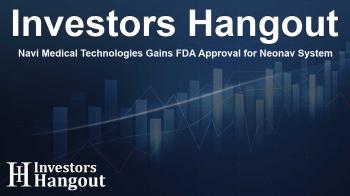Navi Medical Technologies Gains FDA Approval for Neonav System

Revolutionizing Pediatric Healthcare with Neonav
Navi Medical Technologies has reached a significant milestone in improving pediatric healthcare by announcing that their innovative Neonav® ECG Tip Location System has received 510(k) clearance from the U.S. Food and Drug Administration (FDA). This revolutionary technology is now approved for use in hospitals across the United States, enhancing vascular access care for critically ill newborns and children.
Key Features of the Neonav® System
The Neonav® system stands out as the first device of its kind, geared specifically for open heart procedures and vascular access in neonatal and pediatric patients. By employing real-time ECG signal analysis, it ensures accurate placement of Central Venous Access Devices (CVADs), which is crucial in minimizing the risks of misplacement and catheter migration. Such complications can lead to unnecessary hospital costs, potentially amounting to over USD$1 Billion annually for healthcare facilities across the nation.
Enhancing Patient Care with Real-Time Monitoring
One of the most remarkable aspects of the Neonav® ECG Tip Location System is its capability to continuously monitor catheter positioning after initial placement. This feature is an important development as it can detect and prevent serious complications that might arise from catheter movement that goes unnoticed. This proactive approach speaks volumes about how medical technology is evolving to better serve vulnerable patient groups, especially in pediatric care.
Market Expansion and Growth Strategies
With the FDA clearance now secured, Navi Medical Technologies is actively planning to expand its footprint in the U.S. healthcare landscape. The company aims to raise capital to facilitate this expansion while collaborating with hospital networks across the country. Alex Newton, the CEO of Navi, has expressed enthusiasm about this opportunity, highlighting the company’s intent to empower hospitals with advanced technology that significantly enhances patient care for children.
Collaboration with Leading Institutions
Navi Medical Technologies credits its achievement to the invaluable support from investors and partners, which includes healthcare organizations and governmental entities. Such collaborations have played a key role in propelling Navi’s mission to improve pediatric healthcare, making this FDA clearance a pivotal point not only for the company but for the medtech sector as a whole.
Commitment to Innovation and Patient Safety
As a Melbourne-based medtech company, Navi Medical Technologies is committed to driving innovation in pediatric healthcare. The Neonav® system demonstrates a thoughtful commitment to patient safety, ensuring that every critically ill child receives the highest quality of care possible. This focus is essential in a field where the stakes are incredibly high and the complexities of care are ever-increasing.
Voices from the Medical Community
Dr. Janene Fuerch, a well-respected Neonatologist at Stanford Children's Health, emphasizes the need for such guidance systems. She noted that while central lines are essential for critically ill patients, their placement can be tricky. The Neonav® offers a solution by providing real-time feedback to clinicians, improving the accuracy of placements and ultimately the outcomes for young patients.
About Navi Medical Technologies
Navi Medical Technologies prides itself on advancing pediatric healthcare through innovative solutions that are developed in collaboration with leading healthcare professionals. By focusing on the unique needs of neonatal and pediatric patients, Navi is setting new standards in the medical device industry.
Frequently Asked Questions
What is the Neonav® ECG Tip Location System?
The Neonav® is an FDA-cleared medical device designed to assist with the accurate placement of Central Venous Access Devices (CVADs) in neonatal and pediatric patients.
How does the Neonav® system improve patient care?
It uses real-time ECG signal analysis to ensure accurate catheter placement, reducing risks of misplacement and enabling ongoing monitoring after placement.
What impact does the FDA clearance have on Navi Medical Technologies?
The clearance allows Navi to expand its market presence in the U.S., providing access to its innovative technology for improved pediatric care.
Why is ongoing catheter surveillance important?
Ongoing surveillance can prevent serious complications by monitoring the placement and movement of the catheter within the patient’s body, ensuring timely interventions when necessary.
Who supports Navi Medical Technologies?
Navi is backed by a range of investors and partners, including prominent healthcare organizations and government initiatives that focus on growing the medtech sector.
About The Author
Contact Addison Perry privately here. Or send an email with ATTN: Addison Perry as the subject to contact@investorshangout.com.
About Investors Hangout
Investors Hangout is a leading online stock forum for financial discussion and learning, offering a wide range of free tools and resources. It draws in traders of all levels, who exchange market knowledge, investigate trading tactics, and keep an eye on industry developments in real time. Featuring financial articles, stock message boards, quotes, charts, company profiles, and live news updates. Through cooperative learning and a wealth of informational resources, it helps users from novices creating their first portfolios to experts honing their techniques. Join Investors Hangout today: https://investorshangout.com/
The content of this article is based on factual, publicly available information and does not represent legal, financial, or investment advice. Investors Hangout does not offer financial advice, and the author is not a licensed financial advisor. Consult a qualified advisor before making any financial or investment decisions based on this article. This article should not be considered advice to purchase, sell, or hold any securities or other investments. If any of the material provided here is inaccurate, please contact us for corrections.

